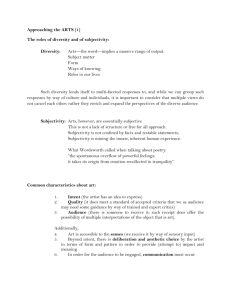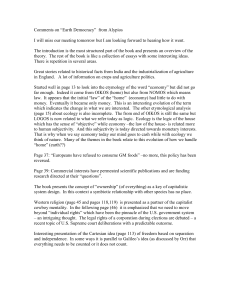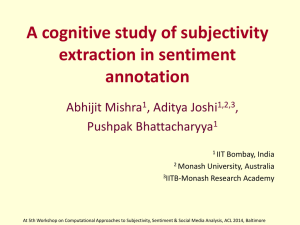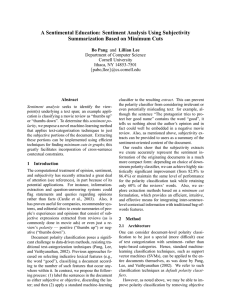Experimental Results
advertisement
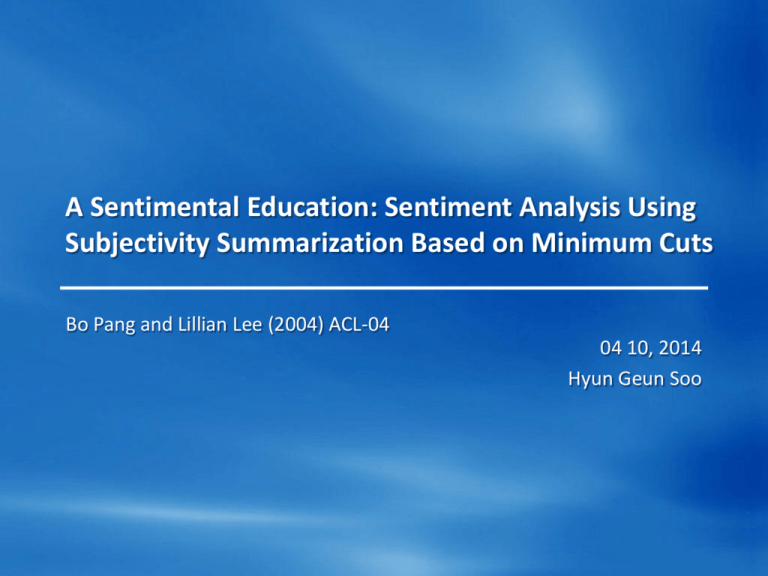
A Sentimental Education: Sentiment Analysis Using Subjectivity Summarization Based on Minimum Cuts Bo Pang and Lillian Lee (2004) ACL-04 04 10, 2014 Hyun Geun Soo Outline Introduction Method Evaluation Framework Experimental Results Conclusions 2 / 19 Intro Sentiment analysis – Identify the view point underlying a text span – Sentiment polarity – E.g. classifying a movie review “thumbs up” “thumbs down” In this paper, – Novel maching learning method – Minimum cuts in graphs 3 / 19 Intro Previous – Document polarity classification focused on selecting indicative lexical feature(e.g. good), classifying the number of such features In this paper, – 1) label the sentences in the document as either subjective or objective and discarding latter – 2) apply a standard machine learning classifier to the resulting extract Prevent, irrelevant or potentially misleading text – E.g. “The protagonist tries to protect her good name” Summary of the sentiment-oriented content of the document 4 / 19 Outline Introduction Method Evaluation Framework Experimental Results Conclusions 5 / 19 Architecture SVM( Support vector machines )… – default polarity classifiers Removing objective sentence (e.g. plot summaries) – subjectivity detector 6 / 19 Context and Subjectivity Detection Standard classification algorithm apply on each sentence in isolation Naïve Bayes or SVM classifiers label each test item in isolation – to specify that two particular sentences should ideally receive the same subjectivity label but not state which label this should be Modeling proximity relationships – Share the same subjectivity status, other things being equal Our method, minimum cuts – Concerned with physical proximity between the items to be classified 7 / 19 Cut-based classification 8 / 19 Cut-based classification Minimum-cut practical advantages – Model item specific and pair-wise information independently – Can use maximum-flow algorithms with polynomial asymptotic running times Other graph-partitioning problems are NP-complete 9 / 19 Outline Introduction Method Evaluation Framework Experimental Results Conclusions 10 / 19 Evaluation Framework Classifying movie reviews as either positive or negative – Providing polarity information about reviews is a useful service – Movie reviews are apparently harder to classify than reviews of other product – The correct label can be extracted automatically from rating information Polarity dataset – 1000 positive and 1000 negative reviews Default polarity classifiers – SVMs, NB Subjectivity dataset – 5000 movie review snippets and 5000 sentences from plot summaries Subjectivity detectors – Basic sentence level subjectivity detector – Cut based subjectivity detector 11 / 19 Evaluation Framework Subjectivity detectors – Source s , sink t = class of subjective and objective – Ind(s) = (denote Naïve Bayes’ estimate of the probility that sentence s is subjective) – . 12 / 19 Outline Introduction Method Evaluation Framework Experimental Results Conclusions 13 / 19 Experimental results Ten fold cross validation Subjectivity extraction produces effective summaries of document sentiment Basic subjectivity extraction – Naïve Bayes and SVMs Incorporating context information – Naïve Bayes + min-cut and SVMs + min-cut 14 / 19 Basic subjectivity extraction Naïve Bayes and SVMs can be trained on our subjectivity dataset Naïve Bayes subjectivity detector + Naïve Bayes polarity classifier – 82% -> 86% improve than no extraction N most subjective sentences Last N sentences First N sentences Least subjective N sentences 15 / 19 Experimental results 16 / 19 Experimental results 17 / 19 Outline Introduction Method Evaluation Framework Experimental Results Conclusions 18 / 19 Conclusion Showing that subjectivity detection can compress reviews into much shorter extracts that still retain polarity information at a level comparable to that of the full review For NB classifier, Extraction is not only shorter but also cleaner representations Utilizing contextual information via this framework can lead to statistically significant improvement in polarity classification accuracy 19 / 19
